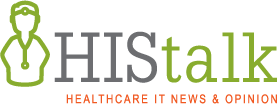Sean Cassidy is co-founder and CEO of Lucem Health of Raleigh, NC.

Tell me about yourself and the company.
I’m an old enterprise software guy, going back to the early 1990s. I’ve been in digital health since about 2004. I’ve worked mostly on big platform type products sold to healthcare providers, such as data integration, data management, and analytics.
The idea for Lucem Health originated within Mayo Clinic a little over three years ago, Mayo Clinic, like a lot of academically oriented healthcare providers that were doing research in AI and machine learning, was struggling to figure out how to deploy AI at scale so that they could deliver real value and impact in the clinical workflow. They went looking for platforms that could be Swiss army knives, for lack of a better term, for the deployment of a broad set of clinical AI type solutions. They didn’t really find anything, so they made the decision to fund the start of a company which later became Lucem Health.
How do health system executives decide when to jump in or experiment with AI among the daily flurry of AI announcements or research results?
It’s important to have a perspective on what the potential value and impact of AI could be to your organization. But primarily, I would orient yourself — as health system leaders are doing these days – to the real problems that are vexing you; for which solutions exist in the market that are novel, unique, and different from what you have seen before; and that can be deployed against those problems and be force multipliers. When you are inquisitive about that, you will find that there is AI at the center of a lot of those solutions.
However, it’s important to note, and this is our perspective, that AI is not a panacea. An algorithm is not a solution. It may deliver a strong and accurate predictive output, but if it can’t be delivered to stakeholders in the right context, right place, and right time, then it’s all for naught. It can’t deliver any meaningful value and it can’t solve for those problems that a healthcare provider may be facing.
Are health systems looking for a turnkey solution to address one specific problem or do they want tools and assistance that can help them develop their own expertise?
I actually think that they are looking for both. It depends on the context.
There is a certain class of provider, large providers that do a lot of research and development in a variety of areas, who are struggling with the bench-to-bedside problem. Their problem is not necessarily a technology-oriented problem, but it turns out that they need technology to solve for that.
But let’s take a provider organization that doesn’t have a data science team and is not doing research and development. They see, as they are exploring the market, that there is value in opportunity and solutions that may have AI at the center. They are telling us that they would prefer not to invest in point solutions or a fragmented set of underlying technology platforms, but would rather buy or deploy on a consistent and uniform infrastructure.
How hard is it for connect those external AI systems to their underlying data and work around issues with interoperability and terminology?
As your readers know, in healthcare, that’s a pervasive, it’s always an issue that there is heterogeneity in the operating environment, but the data can be represented in different ways and can be semantically different. AI solutions are no different from any other solution that is trying to leverage data that already exists, whether it comes from an EMR or some other modality. There is a curation process that has to occur in order to optimize the data so it can be served to the AI and provide the appropriate context to a broader AI solution so that it can be delivered effectively.
What are the steps involved in talking to a health system that has defined a problem and thinks AI can help solve it?
Leaving aside the business case for deploying it, what we find today is that providers are looking for a clinical and financial yield, an ROI, that is significant. Otherwise, it’s difficult to gin up yet another project to try to optimize data infrastructure that they have already invested in. But in terms of connecting into infrastructure, we deploy what I would define as narrow AI. These are not large language models or generative AI. These are very specific hammers for very specific nails. Their data requirements are not terribly broad. They are fairly narrow. There are, for example, plenty of ECG-based models that are powerful in terms of being able to detect cardiovascular disease. Generally speaking, virtually no optimization and curation is required on that signals data to be able to feed it into most of the models.
There are a number of really interesting models that are using EMR data. Fairly simple stuff, like demographic data plus usually one or two lab values that can identify risk of certain kinds of diseases. Again, there’s a little bit of work that has to be done to do some curation on that data, but because the dataset is relatively narrow, it’s straightforward.
If they have FHIR connectivity available in their EMR, which they should have, we can get those EMR-based models up and running quickly without a lot of effort. FHIR as a standard is starting to take hold, and it’s incredibly useful. It’s a bigger lift if we have to go into their PACS and pull CT images. It’s a bigger lift if we have to go to Philips or GE to get enterprise class 12-lead ECGs, but it’s doable. We are finding that health system integration teams have sophisticated integration tools and are really good at being able to tap into the data that’s needed to make AI sing and dance in the real world.
A new survey found that health system executives believe that AI is ready to address some of their issues, yet few of them have developed an AI plan. Is that because they are looking at specific solutions rather than AI in general?
There is an impedance mismatch. I’ve seen those surveys too. When you poll forward-thinking CIOs, CMIOs, and clinical leaders, they are familiar with the opportunity for AI. Of course they to say that they believe that there’s value here, but when it comes down to brass tacks to actually investing in deploying these solutions, their mindset shifts away from the notion of AI as a technical capability to finding solutions that they can deploy. The tip of the spear for them is the solution and the value of the solution over the technology. We think a very high percentage of people feel that way.
How do you position an AI company in a constantly changing environment?
We talk about that a lot. We have to be solution oriented and solution focused. When we package and position what we are taking to market, we are trying to confront real-world problems. The fact that AI is part of the equation is, to a large degree, incidental. We are in conversations with healthcare providers where AI barely comes up. We’re talking about how to identify undiagnosed diabetics, how to get people into the clinic for overdue screening colonoscopies, and how you deal with undiagnosed or undetected breast cancer from mammographies.
The other thing that we talk about a lot is that the solution matters. What we mean by solution is not just the ability to connect with data and to deliver a novel, powerful insight into a clinical workflow. How do you set up infrastructure? How are you capturing telemetry or instrumenting the process so that you can understand whether the thing is delivering the value and impact you expect? Do you have facilities in place to actually make improvements to that over time?
Every provider organization is different. They are different culturally. They are different in terms of the patients they see. They are different in terms of their affinity for technology and their ability to change or not change workflows. All of those things matter. A solution that can be highly optimal at XYZ health system may not be working very well at ABC. Why is that? How do we detect and understand that? How do we make the necessary adjustments to ensure that it does ultimately deliver value? Everything that I just said puts the solution at the front of the conversation and puts the technology in the background.
How are health systems involving physicians as they consider the potential of AI?
I have two thoughts on that. One is that we are trying to frame the conversation in such a way — and this is not a bromide, this is truth — that clinicians feel at the end of it that it’s going to help them practice better medicine. We think it is important that they are left with that impression, and that is their ultimate reality.
The other thing is that we believe that changing clinical workflows, trying to change how clinicians are using EMRs when they are already frustrated by their EMRs, is not the way to go. We are trying to bring solutions into clinical workflows that deliver impact that don’t require any modifications to workflows. They may make those workflows more efficient, but certainly won’t make them inefficient. They won’t pop up more alerts or fill their inboxes with more junk. We help them practice better medicine and practice it the way they have been doing it in the past without requiring radical change.
Your website says that you don’t make algorithms or applications. What technologies to bring to the table?
I want to be clear that our solutions have AI at the center, so we work with AI innovators. The best analogy that I can come up with is that we are car makers, not engine makers. We work with engine makers, and these engines are immensely powerful. They have a lot of horsepower. They can spin really fast. They can deliver a lot of impact. But if they are not dropped into a car, they can’t get very far down the road and actually do any good in the world. We have optimized our assembly line to make it easy for us to build a lot of different kinds of cars. We can build an ECG-based solution, an EMR-based solution, an image-based solution, and everything in between. That’s core to what we do, and it’s like breathing to us.
We use the phrase “AI solution ops” to distinguish from MLOps, which is a term that is fairly well established in the industry. What we do is relatively straightforward, and I’ve hinted at it already. So what is the car? The car is the ability to connect to a broad set of data sources, specifically to support the needs of AI. We are not a general purpose integration platform. That’s not what we are trying to build. To provide mechanisms to support the deployment of many kinds of AI, a broad set of capabilities to interpret the output of the AI in a way that’s human interpretable, human readable, and human understandable, and then to provide robust options, including an application framework for delivering AI insights to clinicians, clinical staff, or to supporting staff so they can benefit from those insights. Underneath the covers, all of that measurement of value and impact, continuous improvement stuff that I mentioned. All of that is the car for us.
What are your goals for the company over the next few years?
Not surprisingly, like a lot of companies at our stage, we are focused on growth. We think that we have established a product-market fit. We think that we have established that what we are offering to the market is something that the market actually wants. We know who our buying personas are and we know what market segments we should be engaging with. We are focused on trying to get more and more customers to hear that story and to sign up with us and to deploy our solutions.
When we look three to four years out, our goal is to have a broad portfolio of powerful, impactful, practical, and responsible AI solutions that are confronting the hard clinical problems that are facing providers. Today we are talking about cancers, chronic diseases, and areas where there are existing solutions that have not necessarily delivered the goods that providers expected when they made original investments.
The other piece to the business is that we want to be working with a significant number of large provider organizations who are trying to do AI research and deliver AI impact to the front lines of care within their organizations and potentially even beyond, but are struggling with the bench-to-bedside problem. That’s where we intend to be.
Comments Off on HIStalk Interviews Sean Cassidy, CEO, Lucem Health














































I've figured it out. At first I was confused but now all is clear. You see, we ARE running the…